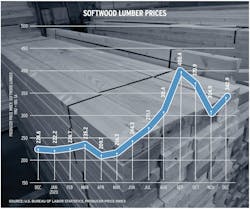Stimulus Expands Financing for Affordable Housing
In a big step forward for housing affordability, the December federal stimulus bill establishes a permanent minimum 4% credit floor for bond-financed projects through the Low-Income Housing Tax Credit (LIHTC).
The 4% credit is typically used for rehabilitation projects and new construction financed with tax-exempt bonds. The new law will make more types of properties financially feasible and will significantly increase production.
The measure could enable multifamily developers to finance more than 125,000 additional affordable rental units over the next decade, making it possible to produce affordable rental housing for lower-income households that would otherwise be financially infeasible.
The LIHTC provision, which the National Association of Home Builders has been seeking for several years, was part of the $900 billion economic relief package approved by the House and Senate on Dec. 21, 2020, and signed into law by President Trump six days later.
RELATED
- Production Builders Taking a New Approach to Affordable Housing
- How Biden Plans to Address Housing Affordability
- Housing Affordability’s Biggest Threats
Over the past 30 years, the tax credit program has generated $344 billion in wages and business income and $135 billion in tax revenue, as well as supporting approximately 3.6 million jobs. Breaking the cycle of poverty begins with access to stable, affordable housing. Because LIHTC properties must generally remain affordable for 30 years or longer, they provide long-term rent stability for low-income households around the country.
Multifamily developers looking to take advantage of LIHTC should contact their state housing finance agency, which allocates credits through a competitive application process. Housing professionals already engaged in affordable housing development may also consider joining NAHB’s Affordable Housing Group for networking and advocacy opportunities.
Lumber Prices on the Rise Again
Seasonally adjusted softwood lumber prices rose 12.5% in December following a 23.9% decline over the prior two months, according to the latest Producer Price Index (PPI) from the U.S. Bureau of Labor Statistics. The softwood lumber PPI remains nearly 15% lower than the record high set in September, but data from Random Lengths suggests that the index will increase more in January as the bureau survey captured rising prices for late-December and the first half of January.
In addition to nominal price movements and tariffs on Canadian lumber, cross-border purchasers are affected by the strength of the U.S. dollar relative to the Canadian dollar. The U.S. dollar has weakened 12.7% since March, including a fall of 3.5% since lumber prices began rising again in November.
Looking more broadly beyond softwood lumber, prices paid for goods used in residential construction rose 0.7% in December (not seasonally adjusted) and ended the year 5.4% higher than they stood in December 2019, according to the latest PPI.
ABOUT NAHB: The National Association of Home Builders is a Washington, D.C.-based trade association representing more than 140,000 members involved in home building, remodeling, multifamily construction, property management, subcontracting, design, housing finance, building product manufacturing, and other aspects of residential and light commercial construction. For more, visit nahb.org.
About the Author

National Association of Home Builders
The National Association of Home Builders (NAHB) is a Washington, D.C.-based trade association representing more than 140,000 members involved in home building, remodeling, multifamily construction, property management, subcontracting, design, housing finance, building product manufacturing, and other aspects of residential and light commercial construction. For more, visit nahb.org. Facebook.com/NAHBhome, Twitter.com/NAHBhome

